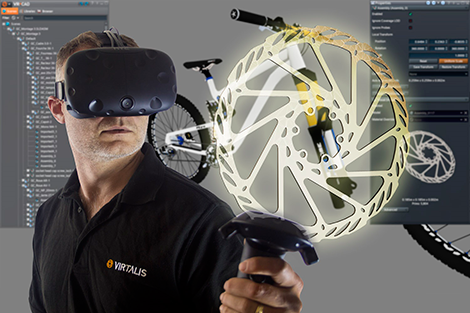
Having announced the product last month, Virtalis has given us our first look at VR4CAD – its tool to take professional 3D CAD models into cost attainable head-mounted displays (HMD).
The race to make best use of enterprise VR has heated up in the latter half of 2016 as HMDs have become more attainable to the designer at their desktop, yet the software has yet to have caught up.
Step in Virtalis, purveyors of Visionary Render for large scale virtual solutions – giant caves, power walls and the likes – which has downsized and simplified the product to make it quick and efficient for use on headsets, with an entry level price of £2,000 per annum (£999 before 31 December 2016).
Despite the caveat that it needs to be running using a Nvidia Quadro, VR4CAD runs on a ‘standard CAD workstation’ that the majority of designers will already be using.
You pick your 3D CAD appropriate version – from CreoView, SolidWorks, Autodesk Inventor, CATIA V5, Open JT, Unigraphics NX, FBX, Collada – and with a ‘plug-and-play’ designed set-up, the file you open is already aware of whatever HMD you have plugged in, and all you have to do is launch the file.
It’s a very fast and intuitive set-up, and once inside full 3D VR the system can save viewpoints, annotations and snapshots, which are stored as an additional file alongside the CAD file.
VR4CAD also boasts ambient occlusion and shadowing with reference objects to enhance the scene. Although the photorealism of Visionary Render is missing, and backgrounds are currently limited in number, there’s still a great deal of spacial realism that lets you get in among parts, spot potential collisions and help you prepare for taking the model to the next stage (such as a power wall customer presentation).
“With HMDs now retailing for less than £700 and a decent VR-capable graphics card costing £1,000-1,500, we analysed the SME market place and realised what was stopping them benefiting from VR was the price of the software,” said Virtalis’ sales director Steve Carpenter.
“Our blue chip clients, like Siemens, BAE Systems and Raytheon, acknowledge that our VR technology saves them money right across the product lifecycle, with other engineering firms, like CNH, using VR for market research and marketing too. Now, for the first time, these advantages come within the grasp of the SME.”
All licences bought before 31 December will cost £999 for the first year. After that date, only the first licence within an organisation will be sold at this price for the first year only, with years two and three priced at £2,000 per annum or a perpetual licence for £5,000.
If the customer decides to upgrade to Visionary Render, then the full price of the VR4CAD licence is discounted, as long as the new licence is licensed to the same computer.






